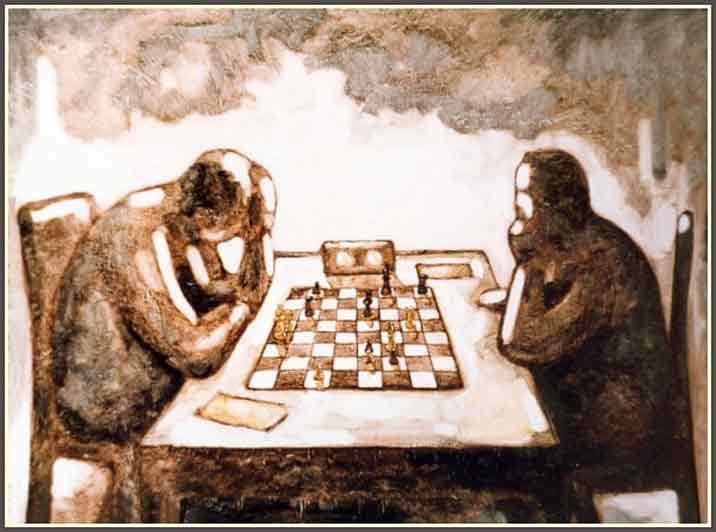WHY IS THE MIDDLE GAME SO HARD?
The course of a typical chess game can be divided into three phases: the opening, the middle game and the endgame. In order to become a strong chess player, one should obtain a certain level in all three phases of the game.
However, one of the most common dilemmas every chess player encounters is working on and improving his middle game.
What is it that makes studying middle games so confusing, compared to the other phases of the game? In my opinion, there are various reasons:
- Improving your opening or endgame phase is much more straightforward. Having trouble with the French defence? Grab the book about the French, go through your chessbase and see a couple of grandmaster games, learn 15 moves by hearth and.. voila. Your rook endgames are terrible? Grab the Dvoretsky’s endgame manual, analyze some rook endgames and bingo. You should immediately notice improvement in your playing strength.
- On the other hand, the middle game is much more diverse and there are less clear guidelines that indicate how to improve. For instance, you might solve tactical puzzles like Mikhail Tal in his best days, and then never get the chance to employ that skill as you get strangled positionally in a trendy variation of a boring London System.
- In the opening, opponent’s choices don’t have that much of an impact as in the middle game. There are many strong players who play only a couple of systems, know them to a certain degree and never bothered to expand their opening repertoire. In the middle game, the course of the game is much more dependant on the choice of your opponent. For instance, your opponent can make an incorrect sacrifice which suddenly forces you to switch from positional to highly tactical play. Sure, it is not always a must to accept such a sacrifice, but often it is unavoidable.
- On the sub-grandmaster level most of the games don’t even reach the endgame and are decided in the middle game. The most often comment about strong young players is that their endgame play is seriously lacking. Personally, I have been able to reach almost 2200 ELO with truly attrocious endgame play.
Or if you remember the famous Tarrasch quote:
” Before the endgame, the gods have placed the middle game.”

Therefore, it makes a lot of sense to disassemble something as complex as middle game, into something simpler and more understandable. That’s why chess players have introduced a multitude of rules of thumb or chess middle game principles. Learning this principles and having them in mind during the game should hopefully make navigating the middle game slightly easier.
In the remainder of the post we have covered some of the most common middle game principles.
It has to be mentioned that in chess no truth is absolute and that you will often find exceptions that go against these principles.
But let me retort with the saying I have never ever understood:
1. DEVELOP YOUR PIECES
It is debatable whether piece development belongs to the opening or the middle game phase of the game, but it’s importance can’t be overemphasized.
Already as beginners, we are all taught not to undertake any actions (for instance opening the position), while insufficiently developed.
However, it is amazing how often strong players violate that rule. Naturally, sometimes there is a specific reason for that (for instance, our opponent has hindered our developement). But more often than not, we get impatient and start concrete play while forgetting about a certain piece.. or two..
The move 6… Nh5? from our first Featured Sundays game is a nice example of ignoring your development. And keep in mind that Black was not some patzer of the street, but a player with ELO rating above 2000.
And for those who think that only amateur players ignore such basic rules, perhaps the game between Ian Nepomniachtchi and Wesley So from the recently finished Tata Steel chess tournament is well worth checking.

2. TAKE CARE OF HIS MAJESTY
Although this clause might be superfluous because we have just mentioned the importance of piece development, I think it is worth mentioning king safety nevertheless. There are numerous games and whole opening variations revolving about the idea of keeping the enemy king in the centre of the board.
And although there are numerous exceptions where king was safer behind the pawns in the centre, or even went up the board, they are exceptions for a reason.
Generally, once you get the opportunity to castle, you might want to do it. Better sooner than never.
A very nice example of punishing the delay of castling is the following game.

3. EXPLOIT OPPONENT’S WEAKNESSES
The term “weakness” most often refers to a weak pawn. In the lower spheres of the ELO rating system your opponents will inevitably leave some weak points in their positions.
It is important to identify those weaknesses as soon as possible and to take advantage of them.
How does a typical weakness look like? It can be one of the following:
- A backward pawn left without the support of the other pawns
- An isolated pawn left without the support of the other pawns
- A doubled or tripled pawns whose mobility is severely restricted
- An advanced pawn in front of the king that is prone to pawn/piece attacks
- A pawn too far advanced and left without the support of the remaining pieces, etc.
The following game is very nice example of exploiting a weak pawn. Note how the whole action revolved around weak c6 pawn and how the need to defend it tied the Black pieces.

4. EXCHANGE PIECES WHEN AHEAD IN MATERIAL
In general, once you win material, further exchanges should be in your favour. This rule shouldn’t come as a surprise. Consider the following position:
Also, our Features Sundays game is once again a vivid example. If White had played 23 Rxc6, forcing the queen exchange, his task would have been simpler and there would be less chance to blunder something, which actually happened in the game.
5. PAWNS DON’T MOVE BACKWARDS
This principle is very important. Most beginners throw the kitchen sink at their opponent and unleash pawn advances without proper thinking. And once they attack fails miserably, they are left with plenty of weaknesses for their opponent to exploit. Therefore, whenever you are considering a pawn advance, keep in mind that he, unlike Frodo and Samwise, might never return.

6. AN ATTACK ON THE FLANK IS BEST COUNTERED BY ACTION IN THE CENTRE
One of the very important principle about attack and defence. Every chess player has at least once experienced the h and g pawns rushing toward his king. It is useful to have the ground idea about countering such escapades.
And also, if you are contemplating a flank attack, it is good to know that it is most efficient when the pawn structure in the centre is closed (or static, if you wish).
The Sicilian defence is an opening where the above described scenario often occurs.
The following game should really belong to “learning from the best” category, since we see the Najdorf virtuoso, Robert James Fischer in action.
7. OCCUPY OPEN FILES WITH HEAVY PIECES
A file is open when there are no pawns of either colour on it. Utilizing open files is self evident for any strong player, but it is worth mentioning nevertheless.
Once you place your heavy pieces (most often rooks) on an open file, you maximize their potential. This mechanism is particularly effective when there is only a single file open on the board, and control of open files becomes more important as the number of the pieces is reduced on the board.
A rook on an open file can infiltrate the enemy position and threaten the pawns on the 2nd/7th rank, or in some scenarios, introduce a mating threat on the 1st/8th rank.
The most vidvid example of open file control is surely the famous Alekhine – Yates encounter. Note how Black was completely paralyzed with the strongly positioned white rooks on the c-file.
Also, the final combination is well worth remembering.
8. PLAY WITH A PLAN
Another very common principle taught to beginners is to always have a plan. Often it is said that it is better to play with a bad plan, then without a plan whatsoever.
In his book Think like a grandmaster, grandmaster Alexandar Kotov claims that every strong player has a clear plan already around move eight or nine. In the modern, computer era, the move number is probably even lower.
So how does playing with a plan look like? I know I have struggled for quite some time to understand how exactly a plan in chess is executed.
We have already mentioned some points that might be defined as a plan.
Some possible plans might include the following (you will notice that some of the clauses were already mentioned in the article):
- Attacking a weak pawn
- Preparing to attack the king
- Utilizing a weak square
- Undermining the opponent’s centre, etc..

For instance, on move 15 in the afore mentioned Alekhine – Yates game, White’s position is better. His plan includes either invading the sevent rank via 15 Qc7 or start the maneovre to put his knight on the c5 square.
We see from including the word either in the previous sentence that often one’s plan may be highly dependant on the opponent’s moves. Therefore, it is important to remain flexible with your plans, and to be able to adapt your plan according to the circumstance.
Furthermore, we see that Black was unable to prevent both White plans in the aforementioned game. However, there are instances where that is not necessarily so. Which brings us to the next point.
9. PREVENT YOUR OPPONENT’S PLAN(S)
You should always keep track about your opponen’ts plans, as well as your own. And if it is possible, you should do your best to prevent your opponent’s plan.
A practical example? Take the following position into consideration:
10. IF YOU DON’T KNOW WHAT TO DO, IMPROVE YOUR WORST PIECE
Finally, there are certain positions when it is not possible/easy to devise a constructive plan. For instance, sometimes a position is just dead equal no matter what you do or try to do. Other times, finding a plan can be extremely hard and you sometimes simply don’t know how to proceed in a certain position.
In such instances, it is useful to remember the chess evergreen : “If you don’t know what to do, improve your worst piece.”
Sometimes such an approach might not alter the evaluation of a position. But since playing equal positions is also a very important skill to master, with such an approach one can hardly ever go wrong.
As an example, take the following position into consideration:
What should White do here? Double the rooks? Advance the pawns?
Generally, this position should be around equal. But there is still some play left in the position.
Here for instance White can probably try to improve his knight on f3 which is doing nothing and bring it over to the queenside. Therefore, a move like 1 Ne1 is legitimate here, heading for the d3-c5 or maybe d3-b4 route.
Black can prevent this maneovre with a move like 1… Bb5. But this is an indication that there is still some play left in the position.
With this, we have come to the end of this article. I hope you have found some of this principles useful. Naturally, we haven’t included every possible middlegame principle out there, so if you want to add anything, feel free to comment below, or contact us on continents.obp@gmail.com.



Enjoyed this a lot. Thanks
Hi Albert,
Glad you like it, thanks for reading it and commenting 🙂
Cheers, Vjekoslav
Thanks a lot
Very helpful